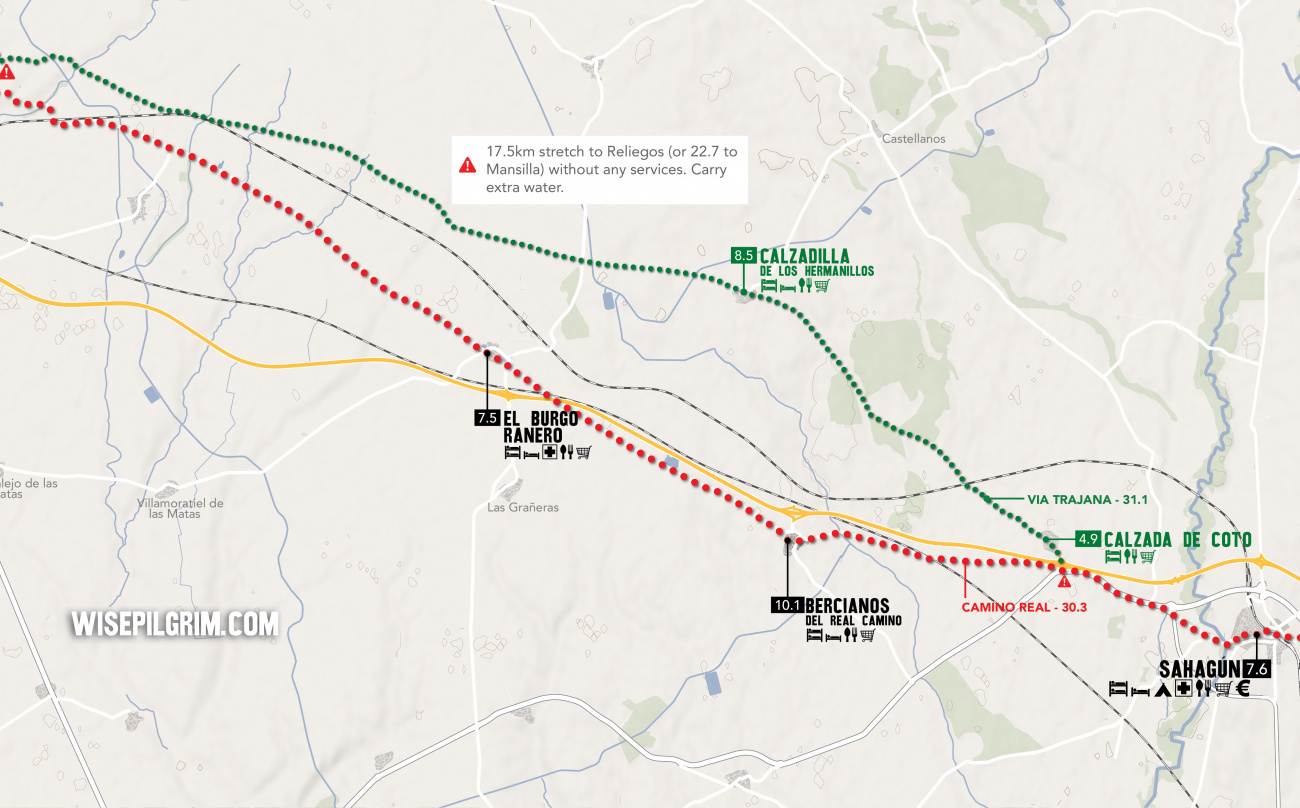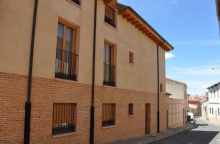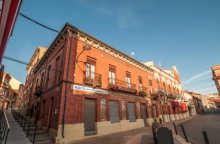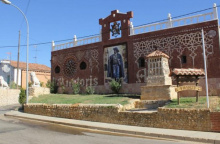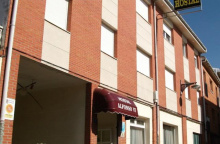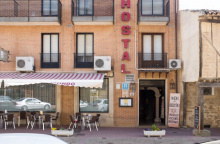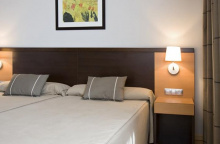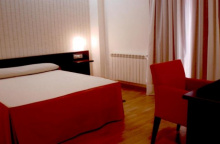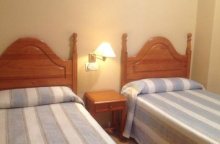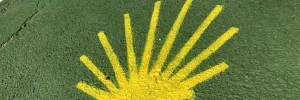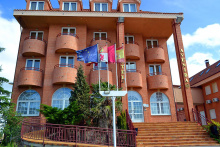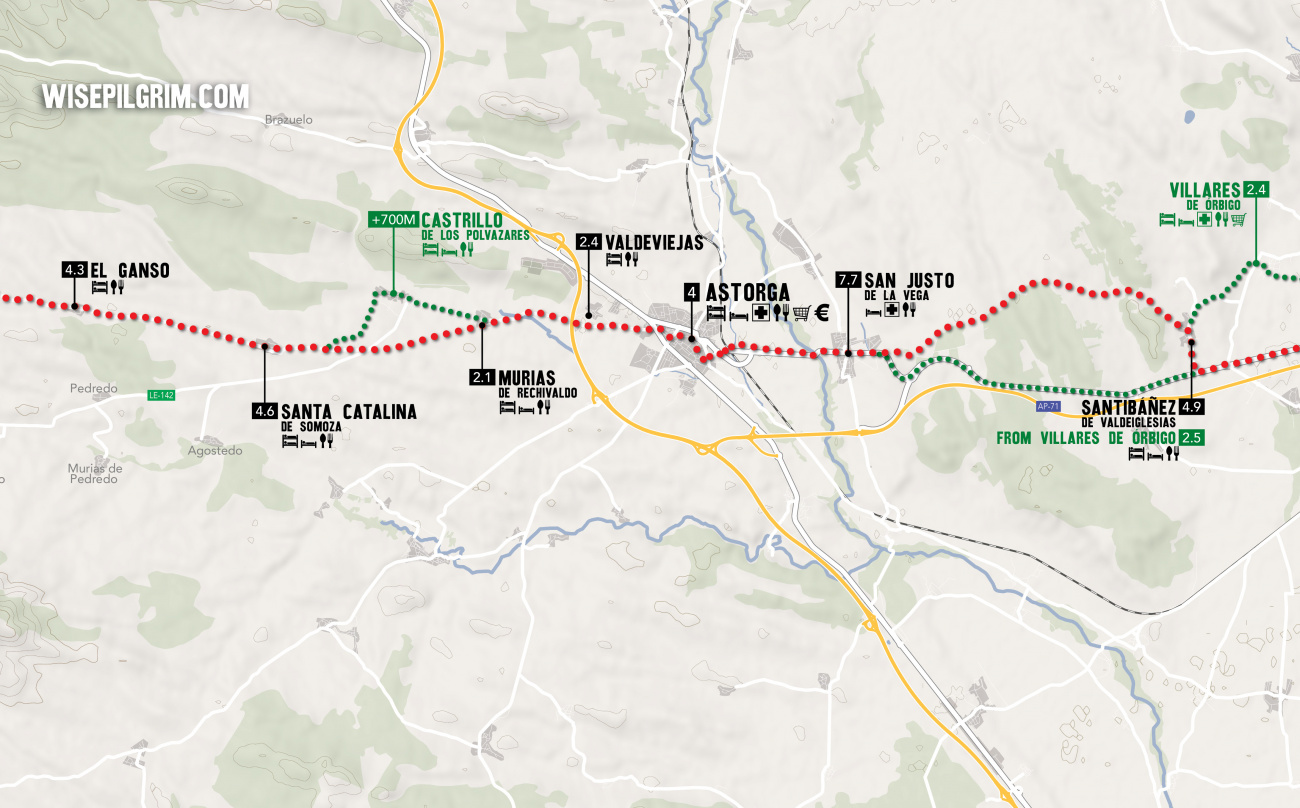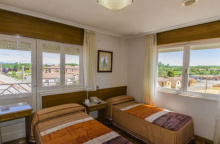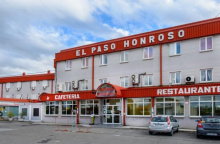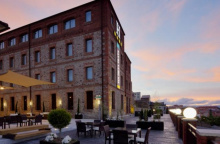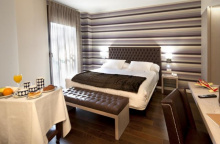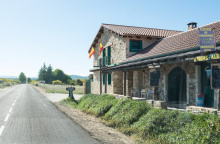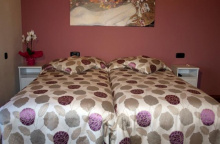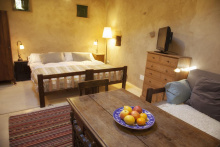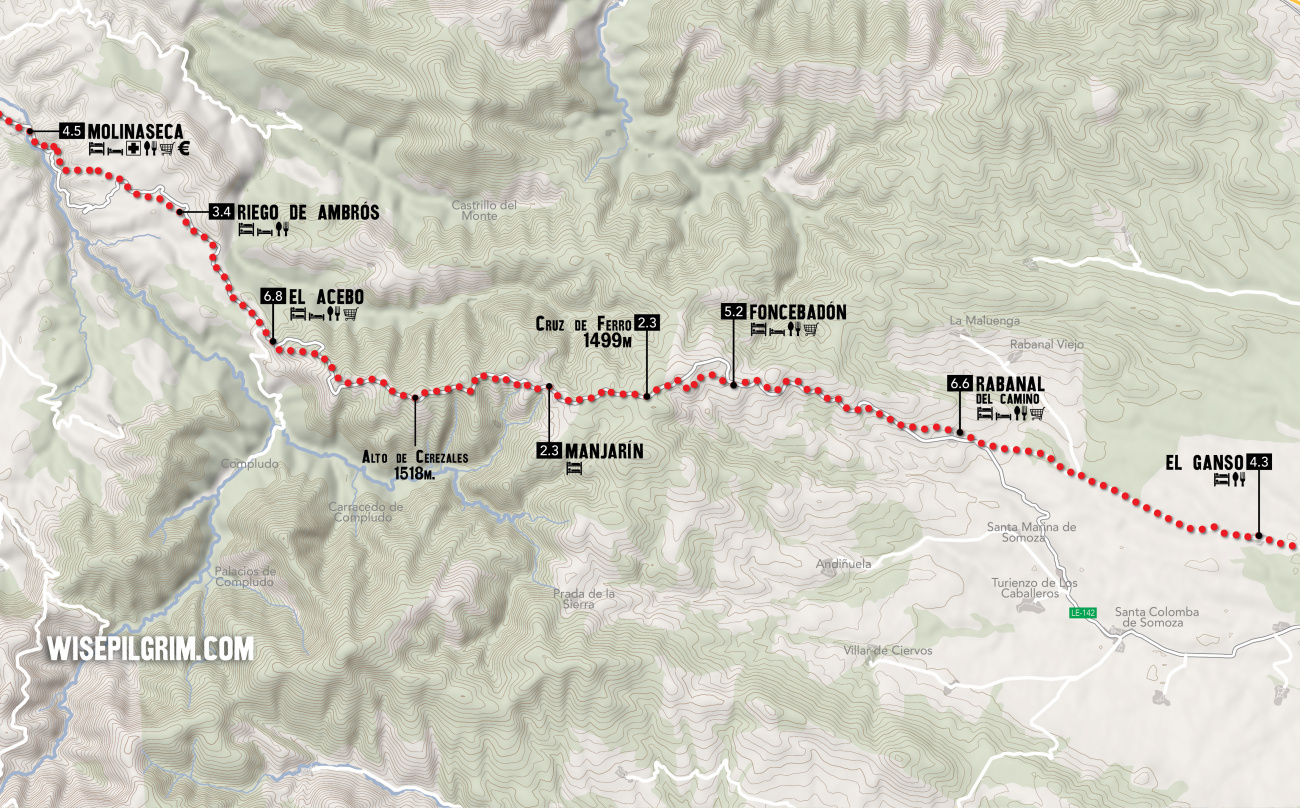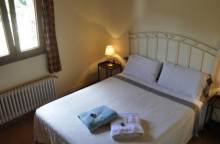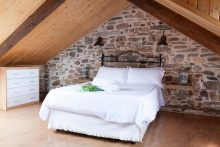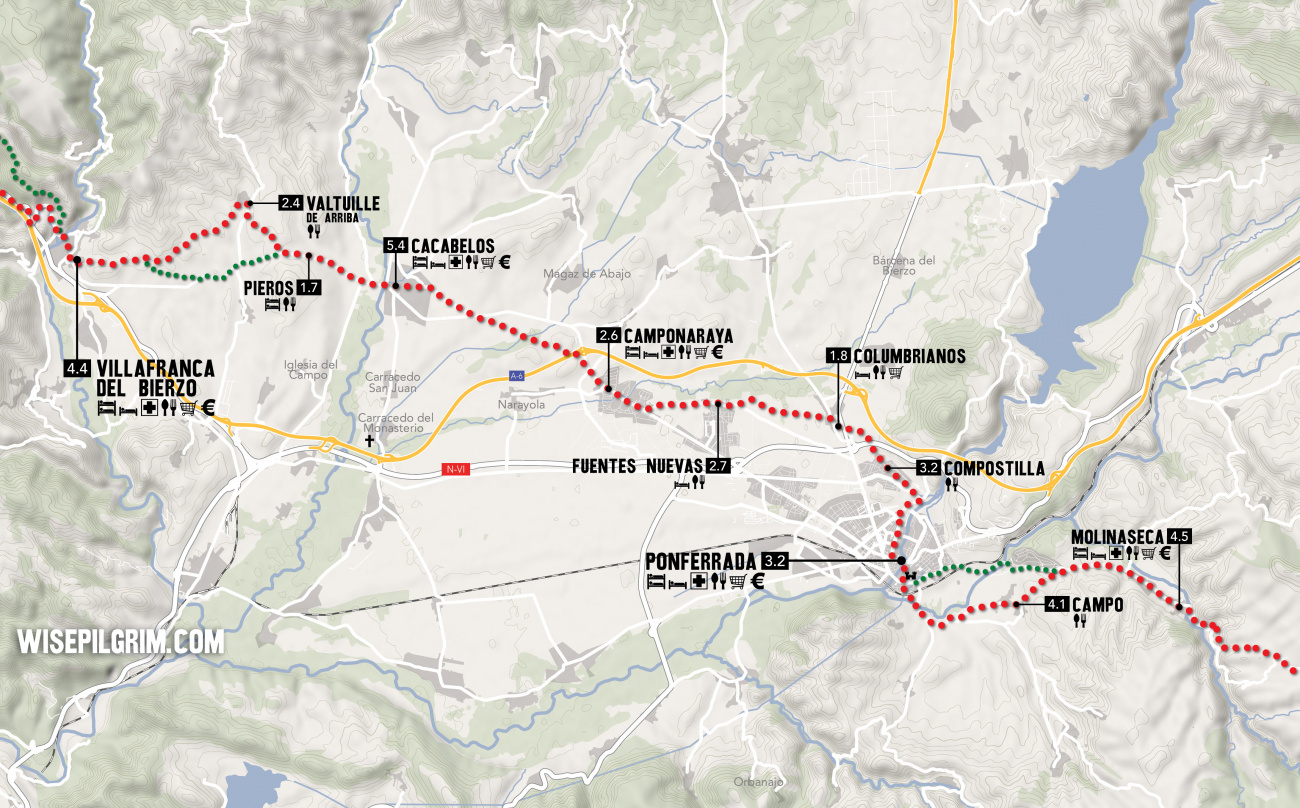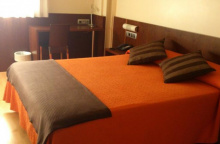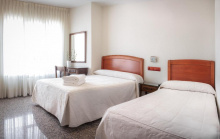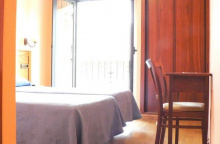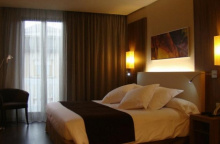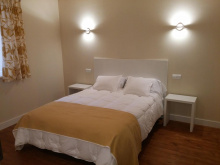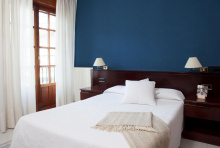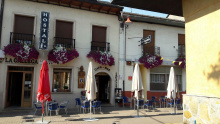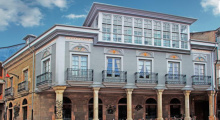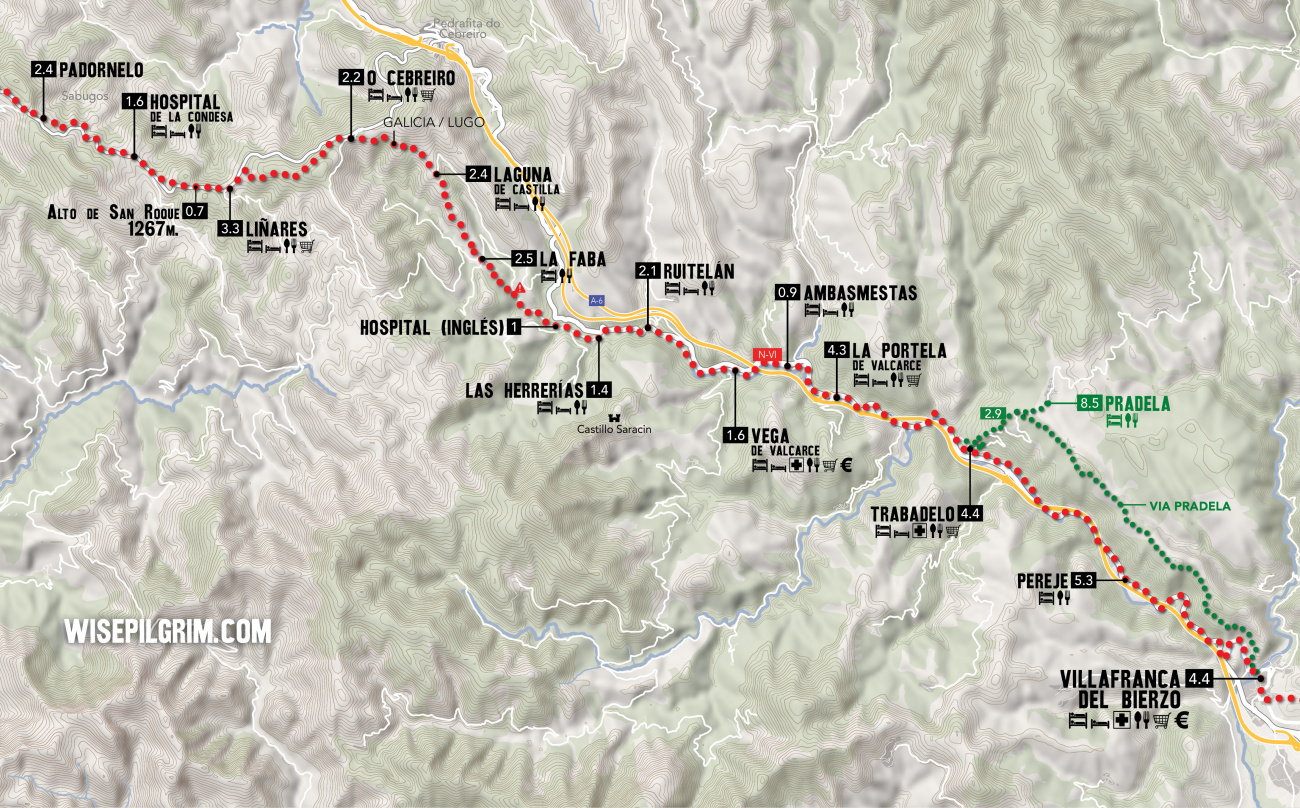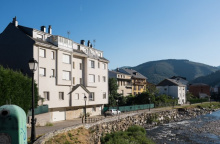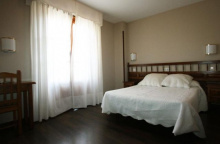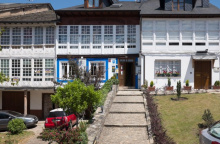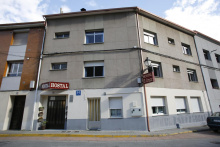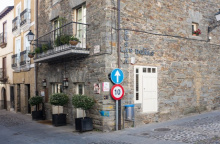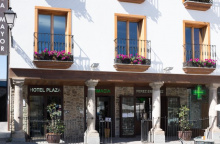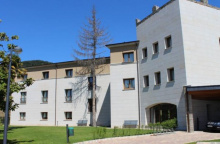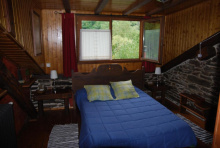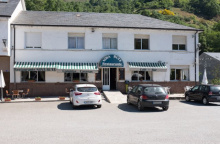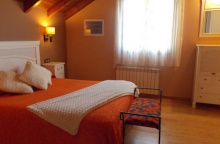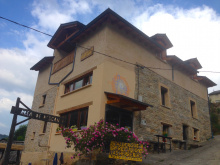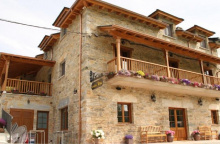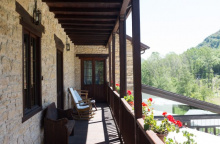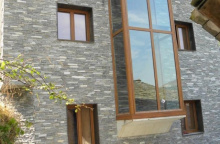More than halfway between San Nicolás and Sahagún the camino departs from the dirt track and crosses the highway. It heads towards the Ermita de la Virgen del Puente. Just beyond the ermita stands a monument which marks the geographical center of the camino, the halfway point. Naturally the math doesn’t quite add up, but you can be certain that you have crossed that half way point sometime between Moratinos and Sahagún.
Accommodation in San Nicolás del Real Camino
| Alberguería Laganares 15€ 20 Booking.com |
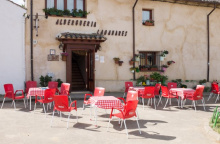
|

The unceremonious crossing into the province of León is by way of the bridge over the río Valderaduey.
León, tucked into the far northwest corner of Castilla y León, was formed from the old Kingdom of the same name. The Meseta begins to wind down, and soon the mountain ranges that form its border with Asturias and Galicia will come into sharp focus.
Perhaps the most celebrated aspects of modern León are its culinary achievements. The city of León is a city that turns out to the streets to celebrate food and drink. Sure, they have adopted a passion for the morcilla (blood sausage) from neighboring Burgos, but they perfected their own cecina (a salted, smoked, beef hind leg) to send back over the border. For drink, they turn to the local Bierzo wine (the heartland of which you will walk through soon), and with increasing frequency craft beers whose hops are grown up-river from Hospital de Órbigo. Given the landscape, it should not surprise that the regional favorite is a wheat beer known as Zerep. A puff pastry known as hojaldre, and a sweet bread called mantecadas, as well as a booming chocolate trade can all be found in Astorga.
The Galician mountains are creeping closer now, and by the time you depart Astorga you will begin the ascent.
If you choose to spend the night in Sahagún do your best to explore the town, it is not the prettiest of places but there are a few gems hiding about that give you a glimpse of its illustrious past. At one time it rivaled Burgos and León in importance and grandeur.
For reasons unknown the town hall has drawn the camino path through town in a way that skips nearly every building worth
seeing, and which bypasses the plaza mayor entirely. If you want to explore you will have to leave the marked path; see green alternative on map.
A very nice certificate is available from the Santuario de la Virgen Peregrina on your way out of Sahagún, a type of half-way Compostela. See the map for the location as it is not on the camino proper.
Sahagún owes its name to the 4th century martyr San Facundo, who along with San Primitivo were buried nearby. Because of this it has seen more than its share of battles between Christians and Muslims. Although the Christians ultimately won out, it was not before the town changed hands no fewer than five times. Each turnover saw the destruction of churches and their reconstruction. Today only 4 of the original 9 churches survive.
Market day is Saturday. Winter pilgrims can celebrate San Tirso on the 28th of January. San Juan de Sahagún on the 12th and 13th of June. Fiesta de Peregrina on the 2nd of July, and San Lorenzo on the 9th and 10th of August.
Accommodation in Sahagún
| Albergue de Peregrinos Cluny 7€ 64 |
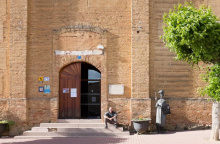
|
| Albergue Viatoris 15€ 50 Booking.com |
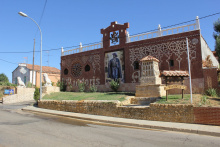
|
| Albergue de la Santa Cruz 7€ 50 |

|

The Camino Real - 30.3
Carry on straight here to follow the route via Bercianos and El Burgo Ranero.
Leaving Sahagún cross over the río Cea. The camino becomes something of a confusion just short of Calzada de Coto, which lies to the north of the A-231. You will find yourself standing at a large highway interchange (4.4km from Sahagún) with a block bus-stop and very little signage to point the way. Distances indicated below are from Sahagún to Reliegos, though the Via Trajana can also bypass Relíegos and go directly to Mansilla de las Mulas without adding any distance The two options rejoin in Reliegos, or Mansilla de las Mulas.
The Camino Real - 30.3
Carry on straight here to follow the route via Bercianos and El Burgo Ranero.
The Via Trajana - 30.9
Turn right here (north) and cross over the bridge to follow the old Roman Road through Calzada de Coto and Calzadilla de los Hermanillos.
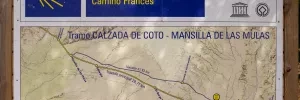
The name of the town tells us that the original inhabitants came from the Bierzo area, and that it is situated along the Camino Real, or Royal Camino. This designation has nothing at all to do with royalty but is rather a term given to primary roads that met a certain metric for size; much like versions of our modern day National highways.
The Iglesia de San Salvador contains a sculpture of St. John the Baptist. The original church tower very nearly lasted into the 21st c., but not quite. The replacement is an uninspiring steel bell tower.
Accommodation in Bercianos del Real Camino
| Albergue Santa Clara 15€ 19 |
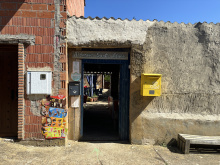
|
| Albergue La Perala 15€ 76 |
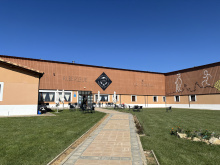
|
| Albergue Bercianos 1900 18€ 20 Booking.com |

|
| Albergue de Peregrinos de Bercianos Donativo€ 46 |

|
| Hostal Rivero | 
|
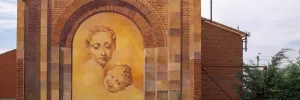
The Via Trajana - 30.9
Turn right here (north) and cross over the bridge to follow the old Roman Road through Calzada de Coto and Calzadilla de los Hermanillos.
As far as the eye can tell the only thing keeping El Burgo Ranero on the map is the business brought in by the camino; the wheat and wool business that once sustained it has been displaced by mechanization.
Although the church in town was robbed of its treasures long ago (some are preserved in the León Cathedral Museum) the bells still ring, and an ever aging congregation turns up daily.
If you are passing through at the right time of year (late May) take a close look at the stork nests on the tower. If you are lucky you may catch a glimpse of the babies waiting for lunch.
El Burgo Ranero owes its existence to both wheat and wool. Of the two it was the wheat (and the granaries that came with) that gave the town its name; though other historians say the name is derived from the same root that gives us the word frog, rana; the wetlands at the far end of town are full of them. In the 10th century sheep were introduced in massive quantities, so much so that it was the largest source of business for most of the region. Migration of the herd started north of here in the mountains and continued south to the extremes of Extremadura.
The camino between El Burgo and Reliegos is along a manicured path lined with trees. Those trees, unfortunately, are on the wrong side of the path, so on sunny summer days you are exposed: bring ample amounts of water.
Accommodation in El Burgo Ranero
| Albergue La Laguna 12-15€ 20 |

|
| Albergue de Peregrinos Domenico Laffi Donativo€ 28 |
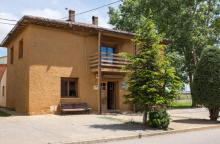
|
| Casa Rural Piedras Blancas | 
|
| Pensión La Costa del Adobe |
| Hostal El Peregrino ⭑ | 
|

The two stretches of road between here and Reliegos are without any services outside of those to be found in Calzadilla de los Hermanillos. Be sure to carry enough water.
Accommodation in Calzada de Coto
| Albergue de peregrinos San Roque Donativo€ 36 |

|

Both Routes rejoin in Reliegos
The camino from Calzadilla once went directly to Mansilla de la Mulas, bypassing Reliegos. The route proved to be less desirable than going first to Reliegos which is close enough. The split occurs 1km before arriving at Reliegos and there may still exist conflicting arrows: to get to Reliegos keep straight at a four-way intersection or to go to Mansilla turn right. Both routes are the same distance to Mansilla.
Accommodation in Calzadilla de los Hermanillos
| Albergue de Calzadilla de los Hermanillos Donativo€ 22 |
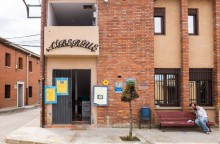
|
| Albergue Vía Trajana 20€ 10 |

|
| Casa Rural Casa El Cura 17 Booking.com |
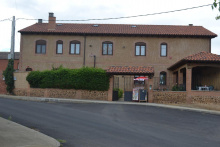
|

Bar Elvis, quite possibly the most famous bar on the whole of the camino, is located in the main square. The owner is quite a character and if you’ve brought your sharpie marker get to scribbling, this is one of the few places where graffiti is encouraged.
Accommodation in Reliegos
| Albergue de Reliegos D Gaiferos 8€ 45 |
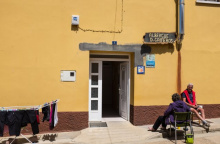
|
| Albergue La Parada 12€ 36 |
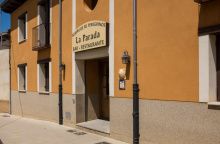
|
| Albergue Gil 13€ 14 |
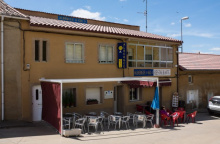
|
| Albergue las Hadas 13-23€ 20 Booking.com |

|
| Albergue Vive tu Camino 18€ 8 Booking.com |
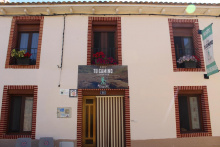
|
| Pensión La Cantina de Teddy | 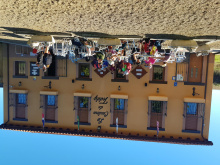
|

There is a nice place for a swim in the river in the northwest corner of Mansilla. Cross over the small pedestrian bridge towards the camping place (not the road bridge that the camino crosses) located in the northwest corner of town. Getting there will take you through several of Mansilla’s small plazas.
Mansilla traces its history back to Roman times, and the walls that continue to surround most of the city bear evidence to its importance; it was both a layover on the Roman road to León and a market town (mostly mules).
The Virgen de Gracia is celebrated on the second Sunday in September. San Martín is celebrated on the 11th of November.
Mansilla still has large sections of its defensive walls, look back when leaving town to get the best view of them.
Much of the way between here and Puente de Villarente is adjacent to the road.
Accommodation in Mansilla de las Mulas
| Albergue El Jardín del Camino 16€ 36 |
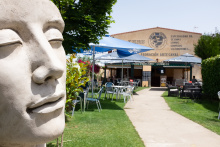
|
| Albergue Gaia 12€ 16 |

|
| Casa Rural Las Singer | 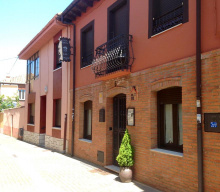
|
| La Pensión de Blanca 14 |

|
| La Casa de los Soportales ★★ Booking.com |
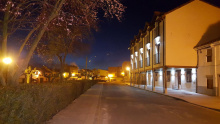
|

If you want to escape the busy road for a bit, bear left at the start of town and follow the arrows through the village. Doing so doesn’t add any distance to your journey but spares you 500m of the road.
When entering Puente de Villarente it is now the bridge, not the river; that poses the greatest threat to pilgrims. Be sure to follow the arrows before the road bridge, they will direct you towards a smaller pedestrian crossing which is a great deal safer.

The river here once posed a serious threat to pilgrims when waters ran high and as a result it became home to several pilgrim hospices.
As you are leaving Puente behind you, keep an eye out for arrows pointing you along a trail to your right-hand side, and up a small hill towards Arcahueja. It is fairly well marked but is along a service road that is often lined with parked trucks and the way might be obscured.
Accommodation in Puente de Villarente
| Albergue San Pelayo 15€ 45 Booking.com |

|
| Hostal La Montaña ⭑ |
The bar is to your left, turn at the playground.
The way continues straight past the small playground and climbs upwards to the Alto de Portillo.
Accommodation in Arcahueja

Valdelafuente the town is not directly on the camino, but rather a few hundred meters off.

It is from the Alto del Portillo that you get your first glimpse of León. It is customary at such a height to search for the spires of León’s magnificent cathedral.
Puente Castro, notable for its bridge, has now grown large enough to merge with one of León’s outer barrios (Santa Ana). There are plenty of places to take a rest and enjoy a beverage; there are still a few kilometers to go before arriving at the center of León.
The barrio and the bridge derive their name from the old Jewish quarter that was once here.
Accommodation in Puente de Castro
| Albergue Santo Tomás de Canterbury 12€ 47 Booking.com |

|

León is now a fully modernized city home to more than half of the population in the province and like Burgos it is worthy of more time than the average pilgrim spends here. To explore in full would take many days, to cover the basics at least two. If you are keen to keep your feet moving every day, consider spending an extra afternoon in León and setting out after lunch for a half day of walking. Between here and Astorga there are two routes to choose from and plenty of albergues.
The Catedral de Santa María de la Regla is a magnificent example of Gothic architecture whose multicolored windows are not to be missed, particularly on a sunny day when the interior is filled with light. The Virgen Blanca on the main portico is a reproduction, the original is in a chapel behind the main altar. You’ll also notice that quite a few sculptures have been removed for restoration.
The Iglesia de San Isidoro is the other not to be missed church; it houses the relics of San Isidoro and is the site of the Panteón de los Reyes where 23 of the Leonese monarchy are resting. It also preserves some of the best, and most intriguing, 13th century Romanesque frescoes as well as the easternmost Holy Door on the Camino Francés.
Fans of Gaudi will not want to miss the Casa de Los Botines, just a short stroll from the Cathedral, and perhaps capture a selfie with a bronze statue of the architect seated on a bench in front.
The best food and the liveliest crowds are in the Barrio Humedo, a twisted knot of narrow streets near the Plaza Mayor whose well-earned name implies that the drinks are overflowing. The region of León is unique in Spain as the only one that grows hops for the production of beer. A few new breweries have appeared on the scene in recent years (Four Lions is recommended) and most produce a local wheat beer known as Zerep.
As you walk around town you will notice several types of plaques embedded in the pavement. One is the impression of the left foot of a Roman soldier (their marches began with the left foot) and marks the boundary of the original Roman settlement and wall. The other, seen closer to the Plaza Mayor, is a symbol of the peninsula and bears the Hebrew word ספרד which translates as Sefarad, the Jewish name for Spain. It was that Jewish population that was expelled from Spain under the Alhambra Decree in 1492. The marker indicates the start of what was once the original Jewish barrio of León.
Nearly one thousand years ago, the city of León was the jewel in the crown of the most powerful king in the Iberian peninsula, at the time a fractured version of what would not become a unified nation for several hundred years. One thousand years before that, it was a Roman settlement critical in protecting the wealth of gold that came from the mines to the west of Ponferrada. Only briefly was it under Muslim control and it holds the distinction of being the seat of Europe’s first democratic parliament.
León hosts one of the more specacular Semana Santa celebrations to be seen along the Camino Francés.
San Juan and San Pedro are celebrated from the 21st to the 30th of June. La Virgen del Camino on the 18th of September. And a romería for San Froilán on the 5th of October.
Perhaps the best place to get your bearings is the Cathedral, and the familiar yellow arrows are visible directly opposite the principle facade. The journey through town is short, passing first the Church of San Isidoro and later the Parador (once hospital) of San Marcos before crossing over the río Bernesga and leaving the city limits. That said, it is several more kilometers through the suburbs of Trobajo and La Virgen.
Accommodation in León
| Albergue Unamuno 13-18€ 85 |
|
| Albergue LeonHostel 17-22€ 20 Booking.com |

|
| Albergue Muralla Leonesa 16€ 80 Booking.com |
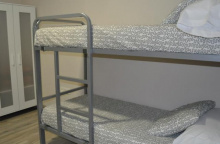
|
| Albergue Check in León 11-13€ 40 Booking.com |

|
| Hostel Covent Garden 20-25€ 26 Booking.com |
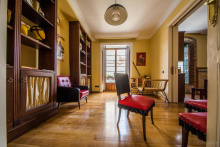
|
| Albergue de Peregrinos de las Benedictinas - Sta. María de Carbajal 8€ 132 |
|
| Albergue San Francisco de Asis 14-18€ 90 Booking.com |
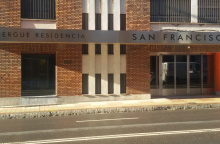
|
| Pensión La Torre Booking.com |

|
| Hostal Albany ★★ Booking.com |

|
| Hostal Alda Casco Antiguo ★★ Booking.com |
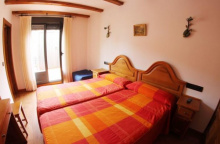
|
| Hostal Quevedo ★★ Booking.com |

|
| Hostal Misericordia Booking.com |

|
| Hotel NH Plaza Mayor ★★★★ Booking.com |
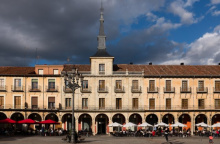
|
| Hotel Le Petit León ★★ Booking.com |
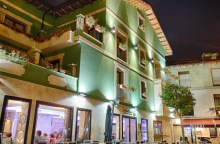
|
| Hotel Real Colegiata de San Isidoro ★★★ Booking.com |
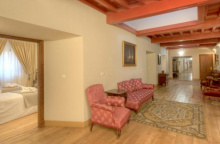
|
| Parador San Marcos Booking.com |

|

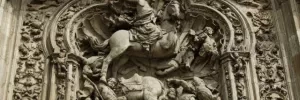
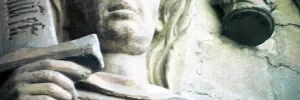
La Virgen del Camino is named for the miraculous sighting of the Virgen by a local shepherd. His vision has been translated into sculptures several times by artists. One is here in the modern looking church, and another is in the León Cathedral (in the Chapel where the daily mass is held).
The sculptures are stunning and bear a resemblance to La Piedad by Michelangelo, with the notable exception that Jesus is facing downwards.
Accommodation in La Virgen del Camino
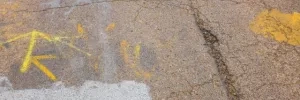
The ROAD ROUTE - 24.6 KM
The official camino route is often called the Road Route due to its proximity to the road. It is the shorter of the two and offers little to no peace from the traffic. To take this route continue straight.
When you get to the Basilica de la Virgen del Camino you will cross the busy road and continue on a small access road. In 300m you are presented with the choice between two routes. The painting of yellow arrows here is confusing, and there is zero official signage to indicate your options. Distances are indicated from La Virgen del Camino to Puente de Órbigo where they converge.
The SCENIC ROUTE - 27 KM
This variation is called the Scenic Route, and it adds < 3km to your journey. It is considerably more pleasant and there are now plenty of services and albergues along the way. To follow this route turn left onto a dirt track.
The ROAD ROUTE - 24.6 KM
The official camino route is often called the Road Route due to its proximity to the road. It is the shorter of the two and offers little to no peace from the traffic. To take this route continue straight.
Accommodation in Valverde de la Virgen
| La Casa del Camino 18*€ 20 Booking.com |
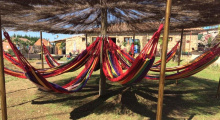
|
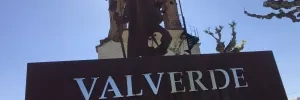
Accommodation in Villadangos del Páramo
| Albergue de Villadangos del Páramo Donativo€ 48 |

|
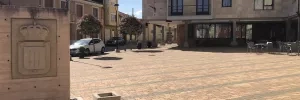
The SCENIC ROUTE - 27 KM
This variation is called the Scenic Route, and it adds < 3km to your journey. It is considerably more pleasant and there are now plenty of services and albergues along the way. To follow this route turn left onto a dirt track.
Accommodation in San Martín del Camino
| Albergue de San Martín del Camino 6€ 68 |

|
| Albergue Santa Ana 8€ 96 Booking.com |

|
| Albergue Vieira 12€ 40 |
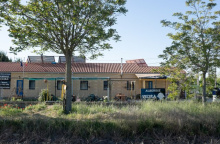
|
| Albergue La Casa Verde 13€ 8 Booking.com |
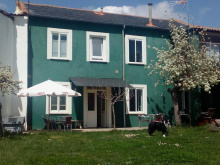
|
| Albergue La Huella 15€ 30 |

|

Accommodation in Oncina de la Valdoncina
| Albergue El Pajar de Oncina 12€ 8 |
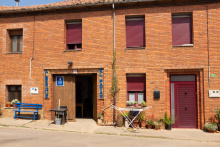
|
| Domus Oncinae Booking.com |
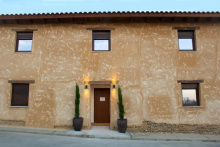
|
One bar, located 50m off the camino to the left and well signed in both directions.

Accommodation in Villar de Mazarife
| Mesón Albergue Tio Pepe 12€ 26 |
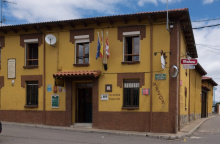
|
| Albergue San Antonio de Padua 12€ 60 |

|
| Albergue Casa de Jesús 9€ 50 |

|

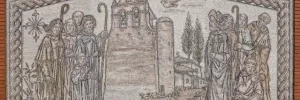
Both routes rejoin as they enter Puente de Orbigo
The camino turns right and into Villavante, though some old yellow arrows continue straight ahead (painted on the elevated irrigation canal). The reason for the detour around town is to avoid a surface crossing of the dangerous rail lines at the edge of town. The distance added is worth the elevated crossing, as the trains pass deceptively fast.
Accommodation in Villavante
| Albergue Santa Lucía 12€ 22 |

|
| Casa Rural Molino Galochas |

Where there are rivers with bridges there is always history to be found. Not much exists on paper, but historians theorize about Suevi and Visigoths battling in the 5th century as well as a few other skirmishes during the 10th century. All of these have been overshadowed by the much more romantic and noble story of Don Suero.
Don Suero de Quiñones was a Leonese knight who made history here in the summer of 1434, though the feats were not recorded until 1588. During that 150 years, we can assume that exaggerations were made, but that is of no matter when you are standing on the bridge and imagining a scene out of Don Quixote.
It was here that Don Suero and nine of his fellow knights defended this pass against all challengers; the event was staged but very much real and was approved by the king as a means for Don Suero to prove his love his lady, Leonor de Tovar. He and his men were determined to break 300 lances but after 166 of the 700 scheduled battles they were too injured to reach their goal. Don Suero, also injured in the event, ultimately set off for Santiago on his own pilgrimage.
A medieval jousting competition is held in early June, recreating the saga of Don Suero. San Juan is celebrated on the 24th of June.
Minor Detour via Villares de Órbigo
When leaving town, the camino once again splits. The preferred (though unofficial) path is to the right, passing through nearby Villares de Órbigo and scenic countryside. Both routes now rejoin in Santibañez, though if you take the road route it is also possible to stay on the road all the way to San Justo de la Vega. Unless it has been particularly rainy the route through Santibañez is the recommended and most scenic route. For either option, take plenty of water when departing Santibañez.
Accommodation in Hospital de Órbigo
| Albergue San Miguel 14-16€ 30 Booking.com |
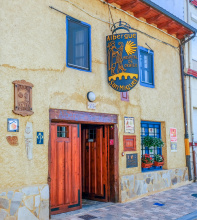
|
| Albergue Verde 13€ 26 |
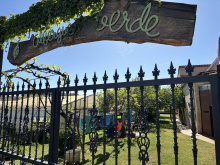
|
| Albergue La Encina 13€ 16 Booking.com |

|
| Albergue Casa de los Hidalgos 15-17€ 18 Booking.com |

|
| Albergue Parroquial Karl Leisner 10€ 90 |

|
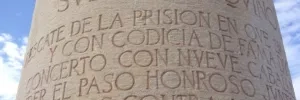

The church here is dedicated to St. James. So too is the church in Santibañes. Both are worth a peek for their representations of Santiago.
Accommodation in Villares de Órbigo
| Albergue Villares de Órbigo 15€ 24 Booking.com |
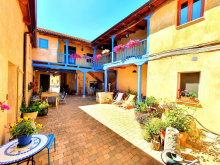
|
| Albergue El Encanto 18€ 10 Booking.com |
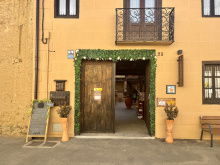
|

The church is often locked up, but if you ask around for the key the locals are always happy to unlock it for pilgrims.
Between here and San Justo de la Vega there are no facilities, but a small kiosk run by pilgrims operates during the busier seasons. Just before the steep descent into San Justo de la Vega is the Cruceiro de Santo Toribio overlooking Astorga in the distance. From this vantage point, you can see the Cathedral of Astorga and the string of towns that dot the camino as it crosses the mountains ahead.
Accommodation in Santibáñez de Valdeiglesias
| Albergue Camino Francés 15€ 24 |

|
| L´Abilleiru Albergue Rural Booking.com |
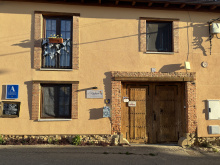
|
| Albergue Parroquial Santibánez Valdeiglsias 8€ 20 |

|

Passing through San Justo, keep an eye out for a bar on the left-hand side called Bar Oasis. It has a corner entrance, a Foosball table, a littered floor, and the BEST tortilla in all of Spain. It is also the thickest tortilla and not to be missed if you are hungry. The owner and his wife are avid travelers and talkers.
Accommodation in San Justo de la Vega
| Hostal Juli ★ Donativo€ 10 Booking.com |

|


In Astorga you may notice a sudden increase in the number of pilgrims, new faces will appear amongst the regular crowd you have grown accustomed to. They are likely Spanish, as this is a common starting point for Spaniards, or they have come from Sevilla along the Via de la Plata. A quick peek at their boots will tell the two apart.
Here you will take first notice of the Maragato culture, the ancient tribe of red-headed Iberians that served as the muleteers between the coast and the interior of Spain. They maintain several curious customs by modern standards, doing most thing the exact opposite as we are accustomed. One of these is their cocido, a meal which is served meat first and greens last. It is a hearty meal and one not to be tackled alone. Grab a group of pilgrims and head off to one of the restaurants serving “Cocido Maragato” for a taste. Be warned, this is not a vegetarian-friendly option.
Later on down the road you have the choice of passing through a well preserved Maragato village where only recently have the locals abandoned their old way of locking their doors: it was their custom to leave the key in the outside door when they left town as a sign to their neighbors that they are gone and as an invitation to the same neighbors to let themselves in if they need anything.
Three buildings of note: 1. The Ayuntamiento (whose animatronic sculptures ring in the hours), 2. The Palacio Episcopal, which was never occupied by the Bishop and which was designed by Gaudi, and 3. the Catedral de Astorga. The last two can be visited on a joint ticket for 5 euros but the opening hours are not always clear.
At the junction of several Roman roads it is no wonder that Astorga is full of Roman ruins. Several dig sights are ongoing and can be toured, and nearly every structure in town has some Roman foundation. This was an important crossroad for the Romans and the gateway into El Bierzo.
Santa Marta is celebrated during the last week of August.
Market day is Tuesday.
The camino here leaves the last of the plains behind and begins, slowly at first, to climb. The ascent is slow and gradual until Rabanal, where it begins a more steep ascent to the alto and an equally quick descent into Molinaseca. On the way up it passes through several small but equipped towns (no ATM but plenty to eat).
Accommodation in Astorga
| Albergue San Javier 12€ 65 |
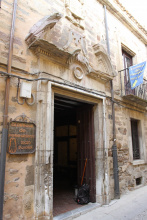
|
| Albergue Só Por Hoje 28€ 10 Booking.com |
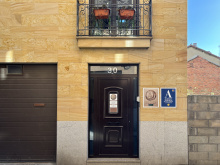
|
| Albergue MyWay 15€ 14 Booking.com |

|
| Albergue de Peregrinos Siervas de María 7€ 165 |



Valdeviejas sits adjacent to the camino and most pilgrims never go into town. There is not much cause to do so unless you plan to stay at the municipal albergue here.
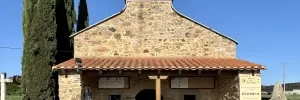
The town is one of a dozen that is considered to be a part of the Maragatería, whose inhabitants are characterized by their red hair, their hard work ethic, and their honest reputation.
Accommodation in Murias de Rechivaldo
| Albergue de Peregrinos Murias de Rechivaldo 10€ 18 |
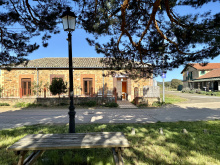
|
| Albergue las Águedas 15€ 40 Booking.com |
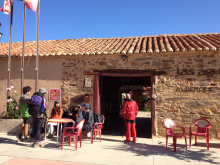
|
| Albergue Casa Flor 15€ 20 Booking.com |
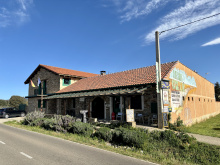
|

Detour from Murias to Maragato village of Castrillo de los Polvazares
With the recent addition of albergues in Castrillo this deviation has become popular for more than just its cultural itinerary. It is a fully restored Maragato village well worth a visit and perhaps a meal. Napoleon is reputed to have spent the night there, where a battle was fought and where the mayor and priest were captured and subsequently rescued.
To get there follow the LE-142 which brought you into Murias. It runs adjacent to the main camino road where a few bars and restaurants are located. To rejoin the camino, follow the road at the far end of Castrillo. The detour adds 700m.
Castrillo has been declared a Historic-Artistic site and the restored village is off limits to non-resident vehicles. The main street has a cross at the beginning and at the end of town, and is lined with large houses. The village dates back to the 16th century, and is a replacement for the old town of Castrillo that was destroyed by a flood.
Accommodation in Castrillo de los Polvazares

The town is the only one on the whole of the Camino Francés to be named after a female Saint (St. Catherine of Alexandria). A relic of St. Blaise is kept in the parish church, and the town was known to have a pilgrim hospital. The ‘Somoza’ part of the name is a simple description of its geographical position at the foot of the hill. The hill, of course, lies ahead.
Accommodation in Santa Catalina de Somoza
| Hospedería San Blas 10€ 24 |
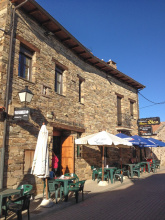
|
| Albergue y Centro de turismo rural El Caminante 10€ 16 |

|
| La Boheme Donativo€ 16 |
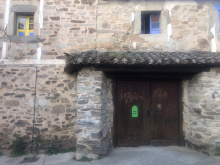
|
| Hotel Rural Vía Avis Booking.com |
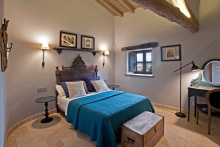
|


Water fountain adjacent to the church. Surrounding the town are several low stone walls that used to hold cattle and sheep, you will be forgiven for thinking that the village was falling down around you.
Home of the Cowboy bar, and that other bar.
Accommodation in El Ganso
| Albergue Gabino 13€ 26 |
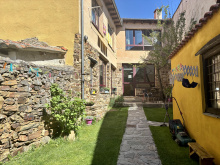
|
| Albergue Sigo Mi Camino 10€ 10 |
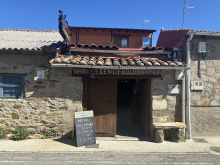
|
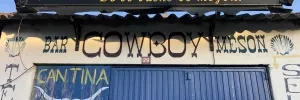
Now home to 4 albergues and many pensions, Rabanal is a common (and wise) stopping point along the way. Ahead is a high mountain pass that demands a bit of rest.
Vespers are sung by the monks every night at 7pm at the small parish Iglesia de Santa María and a benediction for pilgrims is held afterward.
The town has always enjoyed a level of prosperity because of the camino, and in recent years has developed a slightly bohemian feel.
As the camino leaves Astorga, the terrain becomes more rugged and the risk to pilgrims (historically speaking) increased. It is for this reason that the Knights Templar settled here and in the larger town of Ponferrada on the other side of the mountain.
The camino leaves town along the same cobbled path that you found at the start of town, which leads past the church. It does NOT leave along the road.
Accommodation in Rabanal del Camino
| Albergue Municipal de Rabanal del Camino 10€ 34 |
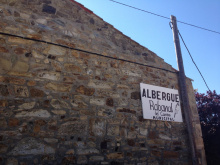
|
| Albergue Nuestra Señora del Pilar 10€ 72 |
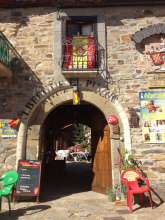
|
| Albergue La Senda 10€ 24 |
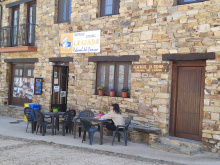
|
| Refugio Guacelmo Donativo€ 37 |

|
| Apartamentos Rurales Las Carballedas Booking.com |
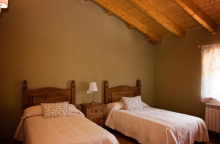
|
| La Posada de Gaspar Booking.com |

|
| Casa Indie ★★★ Booking.com |
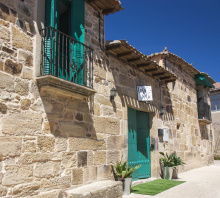
|
| La Candela Booking.com |

|
| The Stone Boat | 
|
| Posada El Tesín Booking.com |

|
| Hostal El Refugio | 
|
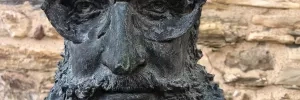
Various guidebooks (and a few novels) have given Foncebadón a reputation for being the home of rabid dogs eager for a tasty pilgrim snack. While this may once have been true, it no longer is.
In fact the mountain outpost has experienced something of a renaissance. In between utterly ruinous piles of stone are a smattering of lovingly restored old homes, most of them converted into accommodation for pilgrims.
This elevation is typically shrouded in fog or buried in deep snow; both have their charm.
Foncebadón is perhaps best known as the home of the hermit Guacelmo. He cared for pilgrims as they navigated their way over the often treacherous mountain pass and was protected by King Alfonso VI. This pass was, until the mid 18th century, the preferred route into Galicia and the townspeople of Foncebadon dedicated themselves to marking the way and serving as guides.
The Cruz de Fierro, or Iron Cross, is a steady climb ahead. If you stopped at the road-side bar be sure to get back to the camino and avoid following the cyclists as they take the road.
Accommodation in Foncebadón
| Albergue Monte Irago 12€ 12 |
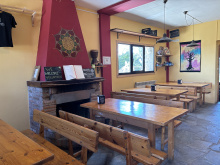
|
| Albergue La Posada del Druida 15€ 20 Booking.com |
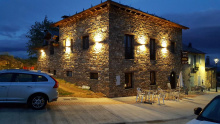
|
| Albergue El Convento de Foncebadón 14€ 24 Booking.com |
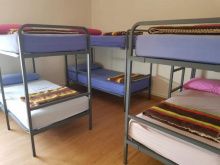
|
| Albergue Casa Chelo 15€ 8 |
|
| Albergue La Cruz de Fierro 15*€ 34 |

|
| Albergue Parroquial Domus Dei Donativo€ 18 |

|


The Iron Cross marks the highest part of the mountain pass and has become the place where pilgrims the world over leave behind a stone brought with them from home or elsewhere on the camino.

In 2022 the last inhabitant of Manjarín closed the doors for good on the modest pilgrim refugio that for decades cared for pilgrims along this very remote pass.
These days a food truck has parked nearby to serve pilgrims.
There are a few stretches of road ahead, just before arriving in Acebo, that are rugged and slippery in wet weather.
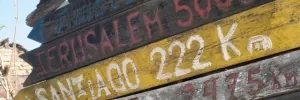

You will first make sight of Acebo (from holly, as in the hardy evergreen shrub) as you descend from above. It is a single road town and typical of the area.
Acebo is a typical mountain village, with rickety wooden balconies suspended over the road. All stone construction and slate roofs are common, the slate coming from a quarry not far off.
This mountain pass was maintained by the villagers of both Acebo and Foncebadón. They installed several hundred stakes to mark the way during heavy snowfall. For their efforts they received an exemption from the tax man.
You will first make sight of Acebo (from holly, as in the hardy evergreen shrub) as you descend from above. It is a single road town and typical of the area.
Accommodation in El Acebo
| Albergue Mesón El Acebo 10€ 16 |
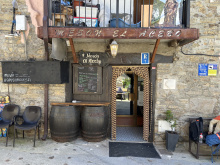
|
| Albergue La Casa del Peregrino 12€ 88 Booking.com |
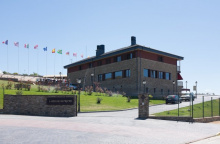
|
| Albergue Parroquial Apóstol Santiago Donativo€ 23 |
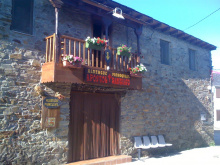
|

Accommodation in Riego de Ambrós
| Albergue de Riego de Ambros 8€ 26 |

|
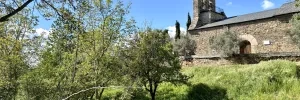
Molinaseca is a popular weekend destination for ponferradinos, who make the short drive to swim in the dammed up río Maruelo. The riverfront makes for an excellent place to swim, cool down, and mingle.
If you are in Molinaseca on the 17th of August, beg borrow or steal a bucket and prepare for the citywide water fight. The day prior celebrates San Roque and the day after celebrates the Fiesta de las Angustias with a more traditional procession through town.
Between Molinaseca and Ponferrada you will be almost exclusively on the sidewalk adjacent to the road. Three kilometers from the center of Molinaseca the camino splits. The camino technically turns left at the curve in the road and passes through Campo on the way to Ponferrada. Turning right to follow the road will get you to Ponferrada just the same and is a shorter path to the Municipal albergue.
Accommodation in Molinaseca
| Albergue Molinaseca - Santa Marina 11€ 40 |
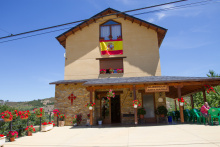
|
| Albergue Señor Oso 13€ 16 Booking.com |

|
| Albergue Compostela 12€ 31 |

|
| Albergue Lua Bierzo 15€ 4 |

|

Campo was once the Jewish quarter of Ponferrada.
Ponferrada’s Templar castle is one of the best-preserved examples of its kind and offers a glimpse into what castle life must have been like in the 12th and 13th centuries.
The Iglesia de Santa María de la Encina is named for a Templar legend according to which her image was found in the trunk of an Oak tree. It is located in the oldest part of town, near the castle.
Ponferrada was at one point one of the most important of the Roman settlements due to its location at the junction of two rivers (The Sil and Boeza) in a valley both fertile and rich in minerals. Its name derives from the construction of its original bridge. Built in 1082 it was one of the first to be decorated with iron and so ‘Pons Ferrata’ became Ponferrada. The original bridge no longer exists.
Saturday is market day. The Fiesta de La Encina begins on September 8th and celebrates the patron Saint of El Bierzo, La Virgen de La Encina (oak), and lasts a week.
Exiting Ponferrada takes you past the castle and briefly through the old town before crossing over the río Sil. At the end of that bridge turn right. The way curves left and at the next large intersection turn right. Keep straight through the first roundabout, and turn right at the second. From here the camino follows temporary signage through construction.
Accommodation in Ponferrada
| Albergue Alea 15€ 18 |
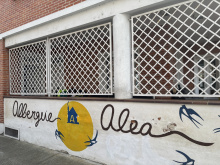
|
| Albergue Guiana 16+€ 50 Booking.com |

|
| Albergue de peregrinos San Nicolás de Flüe Donativo€ 175 |
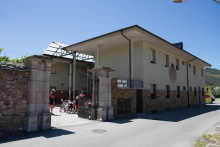
|



Compostilla is a curious place. It was largely built by a private mining and energy company and its rectilinear streets, complete with football pitches and schools, is reminiscent of something out of an upper class North American neighborhood.
On your way through you will pass Nuestra Señora del Refugio, an indication that Compostilla had a place for pilgrims long ago.
You will pass underneath the highway, and past the Ermita de San Blas and San Roque before arriving at Columbrianos where a large zebra crossing takes you over the busy road.


You will pass through Columbrianos quickly and continue along a quiet country road, bypassing much of the industry around Ponferrada. Along the way, you will pass along the outskirts of Fuentes Nuevas and you will get your first good glimpse of the mountains ahead.
Accommodation in Columbrianos
| Casa Rural El Almendro de María Booking.com |

|

The road here begins to enter vine country, and soon the source of El Bierzo’s delicious products become evident. Resist the urge to sample the grapes; they are frequently sprayed with insecticides. So too are the cherry trees, but that doesn’t stop most pilgrims.
Accommodation in Fuentes Nuevas
| Hostal Monteclaro Booking.com |

The way through town is along its busiest road. At the end of town the camino crosses over the motorway and continues through the countryside, back among the vines.
Accommodation in Camponaraya
| Albergue Naraya 12€ 24 |
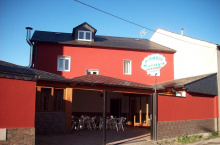
|
| Albergue La Medina 14€ 18 Booking.com |

|
| La Casita Camponaraya 7 Booking.com |
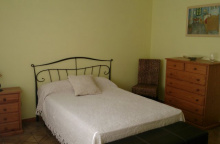
|
Cacabelos is best known for the production of wine, you’ll notice a modern building at the start of town that was built to promote the region.
Take the time to wander the lateral streets and you will be rewarded with several out of the way restaurants. The municipal albergue here has a curious design; horseshoe in shape it wraps around the church and enjoys semi-private two person rooms.
Cacabelos owes its prosperity to the once Archbishop of Santiago de Compostela Diego Gelmírez who gave the instructions that it be rebuilt in 1108. Very few of the churches remain, but the Iglesia de La Quinta Angustia near the river houses a positively unique sculpture of Baby Jesus and Saint Anthony of Padua playing cards.
Although most of his men were drunkenly sacking nearby Villafranca, Sir John Moore’s retreating army scored a small victory here during the Battle of Cacabelos. One of his riflemen, the talented Thomas Plunket, managed to put a bullet in the head of the French cavalry Brigadier General Auguste Colbert from 500m, and another into the head of the officer that came to Colbert’s aid. The balance of the Peninsular War didn’t quite go to Moore’s advantage and following this victory he resumed his retreat towards A Coruña.
The camino leaves town along the road over the Río Cúa and past the church and albergue.
Accommodation in Cacabelos
| Albergue de Cacabelos 6€ 70 |
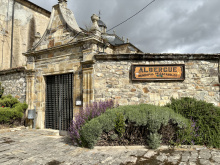
|
| Albergue La Gallega 13€ 26 Booking.com |

|
| Albergue-Pensión El Molino 15€ 16 |
|
| Saint James Way 22€ 15 Booking.com |
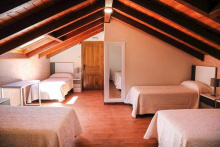
|


The Iglesia de San Martín de Tours still bears the inscription indicating that it was commissioned by the bishop of Astorga. San Martín of Tours was, prior to the popularization of Santiago (and his battle at Clavijo), the patron saint of most of the peninsula.
Shortly after leaving Pieros the camino splits near a set of power lines. The detour through Valtuille, favored for its safety and scenery, is to the right. The road route continues straight for several kilometers before turning off onto a dirt track. This track will rejoin the Valtuille route.

Shortly after leaving Pieros the camino splits near a set of power lines. The detour through Valtuille, favored for its safety and scenery, is to the right. The road route continues straight for several kilometers before turning off onto a dirt track. This track will rejoin the Valtuille route.
Accommodation in Valtuille de Arriba
| Albergue la Biznaga Donativo€ 6 |
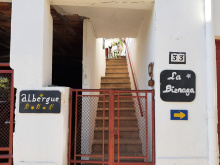
|

The Municipal and Ave Fenix albergues are at the very start of town. The latter is adjacent to the Iglesia de Santiago, one of only two churches along the way to have its own Holy Door for the benefit of pilgrims too sick to make it to the Santiago Cathedral.
Villafranca del Bierzo is one of the prettiest towns along the camino in El Bierzo. It is full of narrow streets that twist and turn and dare you to not get lost.
Located along the Burbia and Valcarce rivers it can be difficult to navigate and steep climbs seem to be obligatory no matter the destination.
The Municipal and Ave Fenix albergues are at the very start of town. The latter is adjacent to the Iglesia de Santiago, one of only two churches along the way to have its own Holy Door for the benefit of pilgrims too sick to make it to the Santiago Cathedral.
San Francisco de Assisi passed through 800 years ago and is said to have founded the Iglesia de San Francisco, do pay it a visit as it often doubles as an exhibition hall (plus its elevation affords a good view as the sun sets in the valley).
During the Peninsular War Villafranca was used as the headquarters for the Galician army and was sacked not once but three times by the English before finally falling into the hands of the French. It is a wonder that any part of it remains.
The most famous Villafranquino in recent centuries is Enrique Gil y Carrasco, a beloved author and world traveler.
The Fiestas del Cristo are held on the 14th of September.
Leave town by way of the bridge over the río Burbia. At the end of the bridge, the camino splits. Most pilgrims keep along the road which winds along the valley floor following the old national VI road, in the shadow of its replacement which soars above. The camino here is on paved asphalt, the old road surface, but is separated from the road by a barrier wall. There are numerous places where it crosses the road, and you are encouraged to watch out for traffic here; it is infrequent but speedy.
Accommodation in Villafranca del Bierzo
| Albergue Municipal Villafranca del Bierzo 7€ 62 |

|
| Refugio Ave Fenix de familia Jato 10*€ 80 |
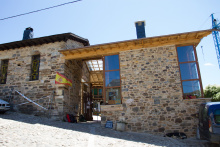
|
| Albergue de la Piedra 14€ 20 Booking.com |
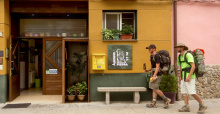
|
| Albergue Hospedería San Nicolás El Real 12€ 150 Booking.com |
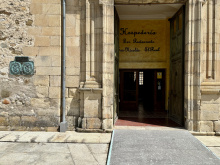
|
| Albergue Leo 14€ 24 |

|
| Albergue El Castillo 14€ 14 Booking.com |
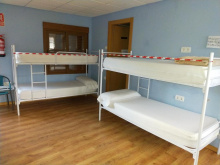
|
| Albergue Viña Femita 14€ 20 Booking.com |
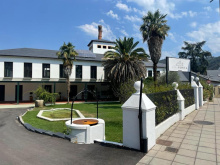
|
| Albergue El Campano 25€ 6 Booking.com |
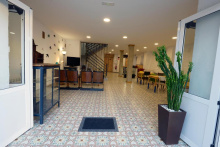
|
| Venecia B&B Booking.com |

|


OFFICIAL ROUTE from Villafranca to TRABADELO, VIA PEREJE
The official route follows the main road leaving Villafranca and passes through Pereje.
ALTERNATE ROUTE from Villafranca to TRABADELO, VIA PRADELA +1.7km
If you fancy a climb and a not too long detour, look for a narrow path on your right immediately after crossing the bridge. It looks like a hastily poured concrete drive and starts off quite steep. The way offers much better views with little to no traffic and it passes through a chestnut forest. There is one town along the way, Pradela, which has a bar and a small albergue.
The route via Pradela adds less than two kilometers of distance to the day, but a not insignificant amount of elevation gain/loss. The two routes rejoin in Trabadelo.
The start of this route is not marked, so if you want to follow it pay close attention after you cross the bridge.
There may be an old woman there warning against the dangers of wolves, of traveling alone as a single woman, or any other strange and deranged reasons. Ignore her and carry on your merry way.
ALTERNATE ROUTE from Villafranca to TRABADELO, VIA PRADELA +1.7km
If you fancy a climb and a not too long detour, look for a narrow path on your right immediately after crossing the bridge. It looks like a hastily poured concrete drive and starts off quite steep. The way offers much better views with little to no traffic and it passes through a chestnut forest. There is one town along the way, Pradela, which has a bar and a small albergue.
The route via Pradela adds less than two kilometers of distance to the day, but a not insignificant amount of elevation gain/loss. The two routes rejoin in Trabadelo.
The bar and albergue are both in the town of Pradela, which sits just off the camino before it descends towards Trabadelo. You do not need to go into town unless you are after a drink or a bed. Otherwise follow the arrows to keep along the camino. The forests here are thick with chestnut trees. If you see piles of prickly looking spheres at your feet, look out from above.
Pradela sits on the hillside just above Trabadelo. The descent along the trail is quick and will deliver you into a side street half way into town; it is also possible to follow the road for a longer but less steep journey.
Accommodation in Pradela (Bierzo)
| Albergue Lamas 12€ 10 |

|
Both Routes rejoin in Trabadelo
Accommodation in Trabadelo
| Albergue La Casa del Pelegrino de Trabadelo 11€ 18 |
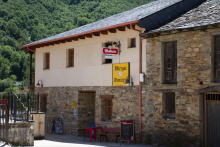
|
| Albergue Crispeta 8€ 48 |
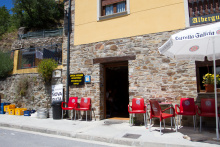
|
| Albergue Camino y Leyenda 20€ Booking.com |
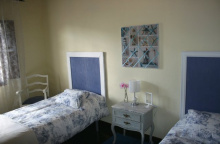
|
| Casa Susi 14€ 10 |
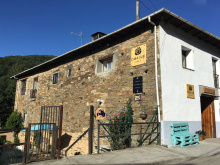
|
| Albergue Parroquial de Trabadelo 9€ 22 |
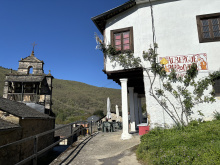
|
| Casa Rural Os Arroxos Booking.com |

|


Accommodation in La Portela de Valcarce
| Albergue El Peregrino 10€ 25 |

|
| Albergue Vagabond Vieiras 15€ 4 Booking.com |
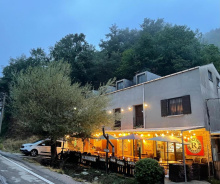
|

Ambasmestas is named for the confluence of the two valley rivers, the Valcárcel (‘valley of the prison’ so named because of its width) and the Balboa. Soaring above you is the A-6 highway connecting A Coruña with Madrid.
Accommodation in Ambasmestas
| Casa Cantadora 15€ |
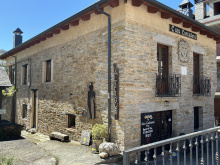
|
| Casa Rural Ambasmestas ★★★ Booking.com |

|
| Hostel El Rincón del Apóstol | 
|

The nearby truck stop of the same name has a full restaurant, as well as a co-op boutique selling local delights like wine, honey, and chocolate. There is also a fruit stand.
The ruins of the Castle of Sarracín are located high on the hill on the other side of the river.
This is the last town with an ATM or a pharmacy until you reach Triacastela.
Accommodation in Vega de Valcarce
| Albergue de Vega de Valcarce 8€ 92 |

|
| Albergue El Paso 15€ 26 Booking.com |

|
| Albergue - Pensión Fernández 15*€ Booking.com |
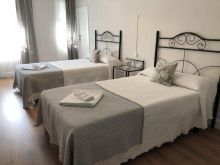
|

San Froilan lived as a hermit in a nearby cave during the 9th century. At the behest of the people of León, King Alfonso III named him as Bishop, a position which he held for only 5 years.
Accommodation in Ruitelán
| Refugio Pequeno Potala 25*€ 12 |

|

Las Herrerias, and the conjoined hamlet of Hospital, are at the base of the mountain that has been lurking on the horizon for a few days.
At the end of town, just past Casa Polin, is a small picnic area and the Fuente de Quiñones (named after the famous jouster of Hospital de Órbigo).
A local service offers to take you to the top of the mountain on horseback, an alternative to the 6km ascent and a taste of what luxury would have felt like 900 years ago.
The climb begins as a gradual ascent along the paved road. The camino will eventually leave this road in favor of a footpath which descends to your left. Arrows at the turn-off indicate that the camino for cyclists remains on the road and if you are on a bike this is the preferred route. When the trail begins to climb again the path is rocky and steep and slick with mud and horse shit. Tread carefully and think happy thoughts.
Accommodation in Las Herrerías

Turn downward for walkers, or up road for cyclists

A small hamlet on the way up to O’Cebreiro, there is little more than a collection of houses, a parochial albergue (run by a German confraternity) and the adjacent church which has a daily evening Mass. Two other bars are in the center of the village, one distinctly Gallego in feel and the other distinctly not. The latter also functions as a small albergue.
Sir John Moore’s very unlucky British army, having been run out of Villafranca by the French, and suffering terrible weather, retreated through these hills on his way to A Coruña. Moore would make it to the port but never escaped the peninsula. He is buried there.
Accommodation in La Faba
| El Rincón del Bierzo 12€ 8 |

|
| Albergue Ultreia Antigua Casa Parroquial 8€ 52 |

|

